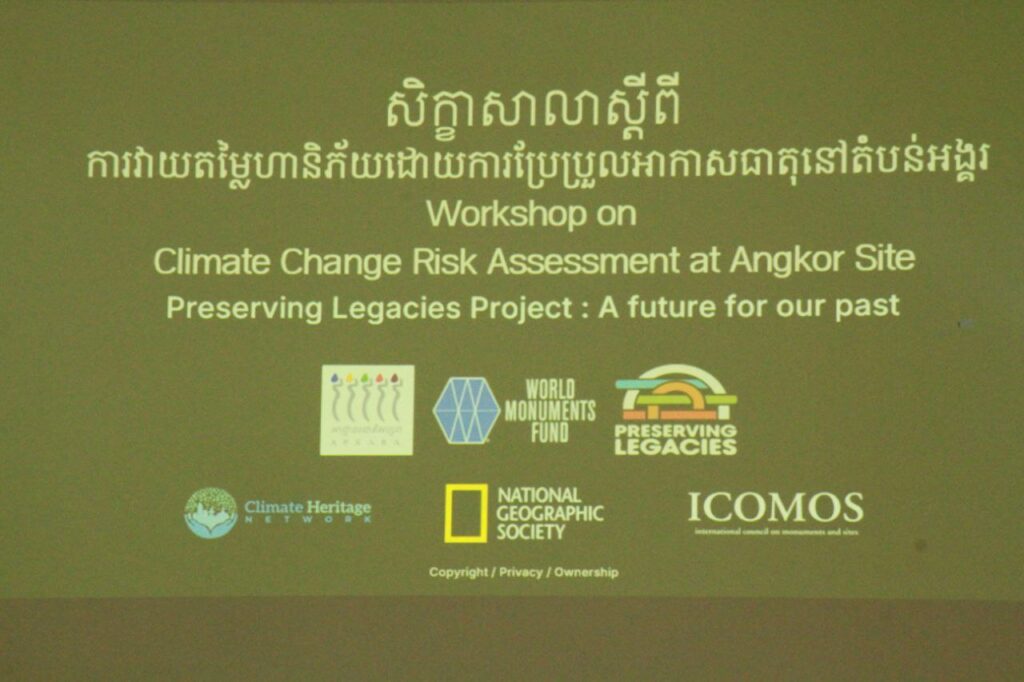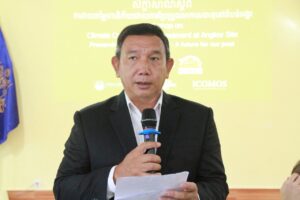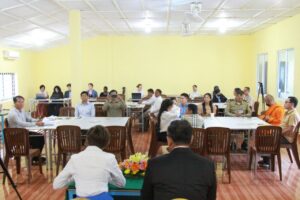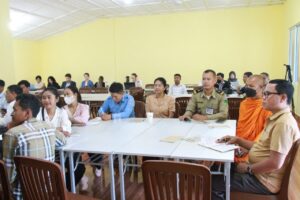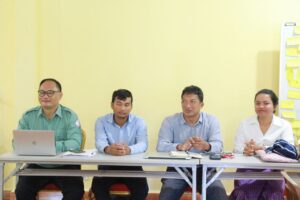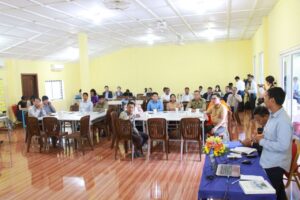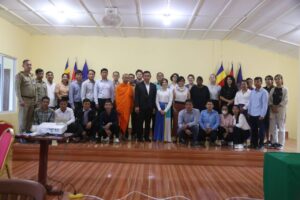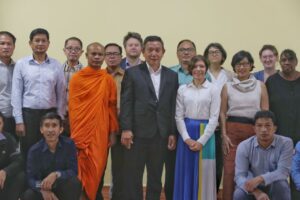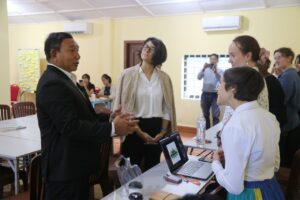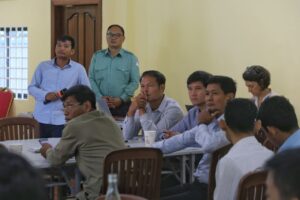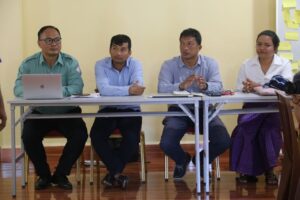នៅព្រឹកថ្ងៃទី២០ ខែវិច្ឆិកា ឆ្នាំ២០២៤ អាជ្ញាធរជាតិអប្សរា សហការជាមួយអង្គការមូលនិធិប្រាសាទពិភពលោក (World Monument Fund) ក្រោមគម្រោង Preserving Legacies បានរៀបចំសិក្ខាសាលាស្តីពីការវាយតម្លៃហានិភ័យដោយការប្រែប្រួលអាកាសធាតុនៅតំបន់អង្គរ ដែលរៀបចំឡើងនៅស្នាក់ការនាយកដ្ឋានសណ្ដាប់ធ្នាប់ នៃអាជ្ញាធរជាតិអប្សរា។
មានប្រសាសន៍ចូលរួមបើកកម្មវិធីសិក្ខាសាលានេះ ឯកឧត្តម គឹម សុធិន អគ្គនាយករងអាជ្ញាធរជាតិអប្សរា ថ្លែងអំណរគុណដល់គម្រោង Preserving Legacies ដែលមានស្ថាប័ន ICOMOS, Climate Heritage Network អង្គការ WMF និង National Geographic Society បានរៀបចំវគ្គបណ្ដុះបណ្ដាលដល់មន្រ្តីចំនួន៣រូប របស់អាជ្ញាធរជាតិអប្សរា និង១រូបទៀតមកពីមន្ទីរវប្បធម៌ និងវិចិត្រសិល្បៈខេត្តព្រះវិហារ តាមអនឡាញ និងដោយផ្ទាល់នៅប្រទេសហ្សកដានី និងប្រទេសហ្វីលីពីន ដោយផ្តោតការយកចិត្តទុកដាក់លើការប្រែប្រួលអាកាសធាតុ និងផលប៉ះពាល់លើតំបន់បេតិកភណ្ឌ។ ឯកឧត្តមបន្តថា បច្ចុប្បន្នអាជ្ញាធរជាតិអប្សរា មានការយកចិត្តទុកដាក់ខ្ពស់ និងរៀបចំក្រុមការងារវាយតម្លៃហានិភ័យនៃការប្រែប្រួលអាកាសធាតុសម្រាប់រមណីយដ្ឋានអង្គរ។ បន្ថែមពីនេះ ឯកឧត្តមអគ្គនាយករង បានណែនាំឱ្យសិក្ខាកាមទាំងអស់ដែលជាថ្នាក់ដឹកនាំ អ្នកអាស័្រយផល និងសហគមន៍រស់នៅក្នុងតំបន់អង្គរ យកចិត្តទុកដាក់រៀនសូត្រ និងស្វែងយល់ពីចំណុចសំខាន់ៗពីវាគ្មិន ដើម្បីយកចំណេះដឹងមកប្រើប្រាស់ក្នុងបុព្វហេតុអភិរក្សរមណីយដ្ឋានអង្គរឱ្យមាននិរន្តរភាព កាត់បន្ថយភាពងាយរងគ្រោះ និងផលប៉ះពាល់ដល់គុណតម្លៃលេចធ្លោជាសកលផ្នែកប្រវត្តិសាស្រ្ត វប្បធម៌ សេដ្ឋកិច្ច និងបរិស្ថាន ដែលកើតឡើងដោយការប្រែប្រួលអាកាសធាតុជាសកលនេះ។
លោកស្រី Victoria Hermann នាយកគម្រោង Preserving Legacies បានថ្លែងអំណរគុណដល់អាជ្ញាធរជាតិអប្សរា ក្នុងភាពជាដៃគូដើម្បីអនុវត្តន៍គម្រោងបណ្ដុះបណ្ដាលខាងលើ។ លោកស្រីបន្តថា ការថែរក្សាមរតកបេតិកភណ្ឌ ឱ្យមាននិរន្តរភាព គឺមានសារសំខាន់ណាស់ សម្រាប់មនុស្សជាតិបច្ចុប្បន្ន និងទៅអនាគត ហើយការសិក្សាពីការគ្រប់គ្រងអាកាសធាតុ នឹងជួយឱ្យយើងមានភាពឈ្លាសវៃដើម្បីការពារ និងអភិរក្សមរតកវប្បធម៌នានាឱ្យបានគង់វង្សសម្រាប់មនុស្សជំនាន់ក្រោយទៀត។
សូមបញ្ជាក់ថា សិក្ខាសាលាខាងលើរៀបចំឡើងរយៈពេល២ថ្ងៃ គឺថ្ងៃទី២០-២១ ខែវិច្ឆិកា ឆ្នាំ២០២៤ ក្នុងនោះមានការសិក្សាទាំងទ្រឹស្ដី និងចុះកម្មសិក្សាផ្ទាល់នៅតាមប្រាសាទ និងការដ្ឋាននានាក្នុងរមណីយដ្ឋានអង្គរផងដែរ៕
អត្ថបទ៖ នាង សំណាង
រូបភាព៖ ហាប់ គឹមអាន, ភោគ ជា
On November 20, 2024, the APSARA National Authority, in collaboration with the World Monument Fund (WMF) under the Preserving Legacies project, held a workshop focused on Climate Change Risk Assessment at the Angkor site. The event took place at the Department of Public Order of APSARA National Authority.
During the opening remarks, H.E. Mr. Kim Sothin, Deputy Director General of APSARA National Authority, expressed gratitude to the Preserving Legacies Project, which includes partnerships with ICOMOS, the Climate Heritage Network, WMF, and the National Geographic Society. He highlighted the training provided to three officials from APSARA National Authority and one official from the Department of Culture and Fine Arts of Preah Vihear Province, both online and in-person in Jordan and the Philippines. The training emphasized the impact of climate change on heritage sites.
Mr. Kim Sothin noted that APSARA National Authority is actively establishing a climate change risk assessment team dedicated to Angkor. He urged all trainees, stakeholders, and local communities to absorb the knowledge shared by the speakers to enhance conservation efforts and mitigate vulnerabilities caused by global climate change on Angkor’s historical, cultural, economic, and environmental values.
Victoria Hermann, Director of Preserving Legacies, also expressed her appreciation for the collaboration with APSARA National Authority in executing this training initiative. She emphasized the importance of sustainable heritage conservation for humanity’s present and future, stating that understanding climate control is essential for protecting cultural heritage for generations to come.
The workshop is scheduled to span two days, from November 20-21, 2024, and will include both theoretical discussions and practical studies at various temples and restoration sites within Angkor.
Article: Neang Samnang
Photos: Hab Kim An, Phouk Chea
Article Translator: Net Phirun

